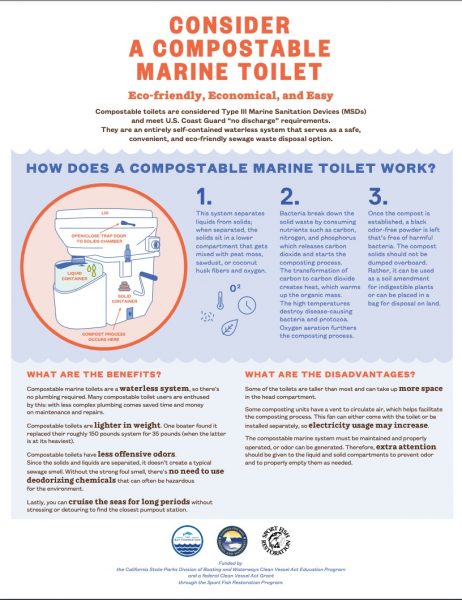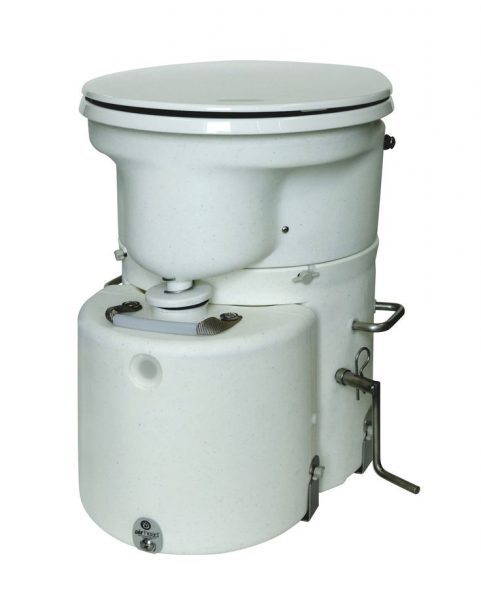
Should We Consider a Composting Head?
We were scanning the recent news releases from the Division of Boating and Waterways and came across a discussion about composting toilets. To us, composting toilets have always seemed like a great idea. No head hoses, pumps and holding tanks to worry about. No need to find and make the always-delightful visit to a pumpout facility, and no need to fix or repair broken head pump mechanisms. Composting heads are nothing if not simple. However, the thought of removing the holding tank plus fitting a composting toilet into a difficult space is an impediment. We’re curious to hear from folks who’ve installed one.

The thought of never visiting a pumpout station again sounds terrific, plus removing the holding tank to open up space to store something more pleasant than waste sounds ideal. It sounds as freeing as buying an electric car and never having to go to a gas station or get an oil change again.

Composting heads seem to make sense on boats and feel as if they’d be a really great idea in drought-prone states like California. Why do we use so much water to move waste to a sewage treatment plant before sending it all back to the ocean?
We’ve seen composting heads at boat shows and remain curious. Who has one aboard?

We do – it was installed by the previous owner, and to be very honest we’d never had much (well any) experience with one. BUT, also to be honest, one of our “hard no’s” when we were looking for boats were standard head with tanks. We’d had boats with that set up in years gone by and for our current purpose this is a great solution. The boat is a Hess designed Falmouth 30 cutter (stretch versiono of a Bristol Channel Cutter). I’m not 100% sure, but maybe 90% that the boat never had a holding tank set up. We don’t use it very much as we’re more “daysailers” than adventureres. (Yeah, I know it’s a blue water boat – but we have it for simple coastal cruising around the Morro Bay / Port San Luis / San Simeon area – my wife LOVES the boat and was the driver to get this one….so how in the world could I complain!?!?!!). Anyway I think they’re a great idea. The “composting” part is kind of a stretch (if you read the detail it actually takes months for actualy composting – so don’t go out and dump it in the garden)…and I think it’s hilarious that they call cleaning it out “harvesting” – but hey, it kind of fits the whole concept. We (affectionaltly) call it “The Catbox” – that’s probably a better description of what it really is. ANYWAY – and joking aside – for casual crusing / daysailing it’s a great way to go and should not be a problem to fit in the space of a conventional head. Our install is actually in a company testimonial – here’s a link: https://airheadtoilet.com/news/composting-toilet-testimonials/. I think you should get one and “enjoy the go” (oh wait, that’s already used)….how about “enjoy the cruise?!). Charlie S/V MINKE – Morro Bay, CA
It’s not likely that the contents of a “dry” toilet will ever effectively compost, even desiccate, in a typical, onboard use scenario. I think this is a point too often ignored, which could quickly result in disappointment and resentment.
It’s probably better to refer to marine “composting heads” as “dry, separating heads”. Sure, a 5-gallon pickle bucket may be fit with a simple seat, to receive unsegregated effluent, but separating urine from feces will result in less objectionable odor and troublesome disposal.
While there are a handful of commercially produced, dry, separating heads on the market, these can be more complex than necessary, and correspondingly more expensive.
It’s possible to produce one’s own dry, separating head, but may be a great deal easier after first securing a urine-diverting toilet bowl, produced specifically for the purpose. These may be made of molded fiberglass or polyethylene. This toilet bowl will help segregate the effluent into separate vessels, usually a 1-2 gallon urine jug, and a 5-6 gallon feces bucket. Dry media such as peat moss or coconut coir will be added to the empty bucket and over each deposit to help control odor and aid quasi-desiccation of feces, while the jug is reserved specifically for urine. Venting and mixing are not strictly necessary for odor control and quasi-desiccating, but if the marketing of these features leaves you feeling warm and fuzzy, by all means succumb to lure of complexity.
Typically, the urine will require more frequent disposal than the feces. How one goes about doing so is up to one’s ingenuity and imagination, but in any event, it’s preferable to do so proactively rather than allow the urine to top the banks of its vessel, fouling the otherwise dry head, or bilge. Think “ahead”. Urine vessels may be fit with simple audio/visual alarm circuits, actuated by a float switch, or one may simply monitor the level visually with a scrutinizing eye and a flashlight. A boisterous sail in the slot will require more consideration that sitting at the dock, obviously, though an overflow is an overflow, whether or not the conditions during which the event occurs are dynamic.
Please, don’t be tempted to dispose the contents of your dry, separating head in the flower beds of the marina. While feces will eventually desiccate and compost into harmless soil, it can take at least a year of apathy to do so, and will pose a biological hazard in the interim. It should also be obvious that a 6-gallon bucket of turds and dry media will realistically overwhelm any conventional toilet ashore. What to “do”? Most municipalities condition the disposal of human waste within garbage bins on its containment. For practical purposes, this means securely containing the waste within a plastic bag as one might do with cat litter, dog poop, and diapers. Consider this within your contemplation of environmental factors. Can you employ compostable bags?
With respect to cruising, it may indeed be possible to compost one’s feces onboard in a series of securely covered buckets, strategically depositing it ashore after a sufficient period of time. Likewise, it may also be possible to discard human effluent into the sea in accordance with regulations.
Every marine sanitary strategy is a compromise. I personally subscribe to the simplest, effective solution, but other people will find greater appeal in a solution in which ignorance and apathy may prevail. This truly could involve an electric head, holding tank, and regular mobile pump-out service.
Having lived with the ‘stink’ for ten years, even with every effort of filters and super hoses, we decided to go dry.
We have lived with our AirHead for more than a year now, full time, and have had several ‘harvests’ that are not offensive or yucky, and if we had a land base would probably go right on the ornamental vegetation. The one issue is the wet part that requires enough draining tha you will want to have two of those bits so you can change them out. We have heard bad stuff about tropical use, but the problems seem to come from being too casual with the use and operation. Inside the boat, no smell, easy to keep clean, and does the job until
you get offshore and can make direct deposits.
We have had an Air Head for over several years and are happy with it. The pee bottles are easy to remove for dumping. For the composter part a plastic bag over the top then invert done. No smells ever. Going on our third boat with an Air Head. Oh they are best mounted in a fore aft setup, otherwise you can only pee on one tack. The best part is there is no smell like the old wet system, and no huge tank of sewage weighing you down.
We installed an Airhead in the aft head and used it for ONE cruising season in Mexico. The composting part worked out OK but the liquid part was awful. If it wasn’t emptied every 24 hours without fail, it would overflow and create a nasty, unsanitary mess. And when sailing, too much of a heel did the same thing. In addition, carrying that bucket of pee up to a marina restroom to dump was not my favorite thing to do. I’m sure they would be fine for folks who are always at the dock or only do short sails from marina to marina, but for long term cruising? Maybe not so much. We happily went back to a marine head after that one year. We also installed an electric toilet in the forward (main) head and it was wonderful. So much easier (and less stressful) for guests and they use fresh water so smell is not an issue.